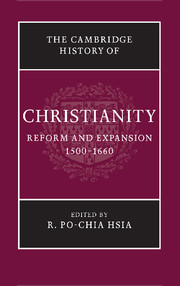Book contents
- Frontmatter
- Part I Luther and the Holy Roman Empire
- Part II The Second Reformation
- Part III Catholic Renewal
- Part IV Resolving Confessional Conflicts
- 13 Peace without concord: religious toleration in theory and practice
- 14 Imposing church and social discipline
- 15 Persecutions and martyrdom
- 16 The Mediterranean Inquisitions of early modern Europe
- 17 Religious colloquies and toleration
- 18 Western Christianity and Eastern Orthodoxy
- Part V Religion, Society, and Culture
- Part VI Christianity and Other Faiths
- Bibliography
- Index
- References
14 - Imposing church and social discipline
from Part IV - Resolving Confessional Conflicts
Published online by Cambridge University Press: 28 March 2008
- Frontmatter
- Part I Luther and the Holy Roman Empire
- Part II The Second Reformation
- Part III Catholic Renewal
- Part IV Resolving Confessional Conflicts
- 13 Peace without concord: religious toleration in theory and practice
- 14 Imposing church and social discipline
- 15 Persecutions and martyrdom
- 16 The Mediterranean Inquisitions of early modern Europe
- 17 Religious colloquies and toleration
- 18 Western Christianity and Eastern Orthodoxy
- Part V Religion, Society, and Culture
- Part VI Christianity and Other Faiths
- Bibliography
- Index
- References
Summary
Social and church discipline are historiographical concepts which have been developed to describe a general trend exhibited by all states and confessional churches during the early modern period of establishing control mechanisms over their subjects or flock. Originally, the concept of social discipline (or disciplining) was developed by Gerhard Oestreich as an alternative to the etatistic term ‘absolutism’. Oestreich described ‘social disciplining’ (Sozialdisziplinierung) as a process in which, based on neo-stoic philosophy, the early modern state strove to control the behaviour of its subjects in all areas of life, thus turning them into ‘obedient, pious, and diligent subjects’. The concept of ‘social discipline’ was also taken up by historians working on the religious history of early modern Europe. ‘Church discipline’, the very diverse measures used by the confessional churches of early modern Europe to discipline their flock, was consequently regarded as part of the larger process of ‘social disciplining’.
Church and social discipline are very complex phenomena and their complexity has to be taken into account in at least four aspects: first, the development of church and social discipline between the late Middle Ages and the period of the Reformation and Counter-Reformation; second, the confessional variations of church discipline, i.e., the attitudes to and expectations of church discipline were decisively influenced by the Protestant reformers’ theological attitudes and by the Catholic reform movement and the decisions of the Council of Trent; third, as a consequence of different religio-political structures in different parts of Europe, there came into existence a wide variety of institutions and procedures of church discipline.
- Type
- Chapter
- Information
- The Cambridge History of Christianity , pp. 244 - 260Publisher: Cambridge University PressPrint publication year: 2007
References
- 2
- Cited by



